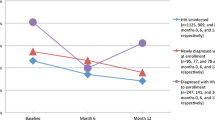Abstract
Safe sexual behaviors and anti-retroviral use help prevent HIV transmission. In this cross-sectional study, we assessed correlates of anti-retroviral (ART) status and transmission risk (a constructed variable) among a convenience sample of n = 1041 HIV-positive women (pre-intervention) enrolled in an evidence-based intervention at four CBOs. Multinomial logistic regression models were used. Younger women and those diagnosed with HIV in the last 5 years more often reported that they had not been prescribed ART. Self-reported non-adherence to ART was less frequently reported among women who were older, had a higher HIV knowledge, and those with attitudes/beliefs supportive of condom use. The highest-risk transmission group (condomless sex with HIV-negative/unknown partner and not prescribed or non-adherent to ART) was associated with younger age, attitudes/beliefs less supportive of condom use, and low self-efficacy discussing condom use. Our findings inform HIV prevention efforts among similar populations of HIV-positive women enrolled in interventions at CBOs.
Similar content being viewed by others
References
Centers for Disease Control and Prevention. Diagnoses of HIV infection in the United States and dependent areas, 2014; 26. http://www.cdc.gov/hiv/library/reports/hiv-surveillance.html. Published November 2015. Accessed 15 Sept 2016.
White House. National HIV/AIDS Strategy for the United States: Updated to 2020. https://www.aids.gov/federal-resources/national-hiv-aids-strategy/nhas-update.pdf. Published July 2015. Accessed 17 Nov 2016.
Bradley H, Hall HI, Wolitski RJ, et al. Vital Signs: HIV diagnosis, care, and treatment among persons living with HIV–United States, 2011. MMWR Morb Mortal Wkly Rep. 2014;63(47):1113–7.
Puskas CM, Forrest JI, Parashar S, et al. Women and vulnerability to HAART non-adherence: a literature review of treatment adherence by gender from 2000 to 2011. Curr HIV/AIDS Rep. 2011;8(4):277–87.
Skarbinski J, Rosenberg E, Paz-Bailey G, et al. Human immunodeficiency virus transmission at each step of the care continuum in the United States. JAMA Intern Med. 2015;175(4):588–96.
Centers for Disease Control and Prevention, Health Resources and Services Administration, National Institutes of Health, American Academy of HIV Medicine, Association of Nurses in AIDS Care, International Association of Providers of AIDS Care, the National Minority AIDS Council, and Urban Coalition for HIV/AIDS Prevention Services. Recommendations for HIV Prevention with Adults and Adolescents with HIV in the United States, 2014. 2014.
Yin L, Wang N, Vermund SH, et al. Sexual risk reduction for HIV-infected persons: a meta-analytic review of “positive prevention” randomized clinical trials. PLoS ONE. 2014;9(9):e107652.
Crepaz N, Tungol-Ashmon MV, Higa DH, et al. A systematic review of interventions for reducing HIV risk behaviors among people living with HIV in the United States, 1988–2012. AIDS. 2014;28(5):633–56.
Raiford JL, Wingood GM, DiClemente RJ. Correlates of consistent condom use among HIV-positive African American women. Women Health. 2007;46(2–3):41–58.
Feldman MB, Silapaswan A, Schaefer N, Schermele D. Is there life after DEBI? Examining health behavior maintenance in the diffusion of effective behavioral interventions initiative. Am J Community Psychol. 2014;53(3–4):286–313.
Absalon J, Della-Latta P, Wu F, El-Sadr WM. Sexual behaviors and condom use of HIV-infected men and women of color attending a treatment and care clinic. J Natl Med Assoc. 2005;97(7 Suppl):25S–31S.
Crepaz N, Marks G. Towards an understanding of sexual risk behavior in people living with HIV: a review of social, psychological, and medical findings. AIDS. 2002;16(2):135–49.
Howard AA, Arnsten JH, Lo Y, et al. A prospective study of adherence and viral load in a large multi-center cohort of HIV-infected women. AIDS. 2002;16(16):2175–82.
Wilson TE, Barron Y, Cohen M, et al. Adherence to antiretroviral therapy and its association with sexual behavior in a national sample of women with human immunodeficiency virus. Clin Infect Dis. 2002;34(4):529–34.
Langebeek N, Gisolf EH, Reiss P, et al. Predictors and correlates of adherence to combination antiretroviral therapy (ART) for chronic HIV infection: a meta-analysis. BMC Med. 2014;12:142.
Centers for Disease Control and Prevention. WILLOW. https://effectiveinterventions.cdc.gov/en/HighImpactPrevention/Interventions/WILLOW.aspx. Accessed 21 Jan 2016.
Wingood GM, DiClemente RJ, Mikhail I, et al. A randomized controlled trial to reduce HIV transmission risk behaviors and sexually transmitted diseases among women living with HIV: the WiLLOW Program. J Acquir Immune Defic Syndr. 2004;37(Suppl 2):S58–67.
Weller S, Davis K. Condom effectiveness in reducing heterosexual HIV transmission. Cochrane Database Syst Rev. 2002(1):CD003255.
Eaton LA, Kalichman SC, O’Connell DA, Karchner WD. A strategy for selecting sexual partners believed to pose little/no risks for HIV: serosorting and its implications for HIV transmission. AIDS Care. 2009;21(10):1279–88.
Niccolai LM, Farley TA, Ayoub MA, Magnus M, Kissinger PJ. HIV-infected persons’ knowledge of their sexual partners’ HIV status. AIDS Educ Prev. 2002;14(3):183–9.
Kalichman SC, Cherry C, Amaral CM, et al. Adherence to antiretroviral therapy and HIV transmission risks: implications for test-and-treat approaches to HIV prevention. AIDS Patient Care STDS. 2010;24(5):271–7.
Wingood GM, DiClemente RJ. Gender-related correlates and predictors of consistent condom use among young adult African-American women: a prospective analysis. Int J STD AIDS. 1998;9(3):139–45.
Panel on Antiretroviral Guidelines for Adults and Adolescents. Guidelines for the Use of Antiretroviral Agents in HIV-1-Infected Adults and Adolescents. Department of Health and Human Services; 2012.
Panel on Antiretroviral Guidelines for Adults and Adolescents. Guidelines for the Use of Antiretroviral Agents in HIV-1-Infected Adults and Adolescents. Department of Health and Human Services; 2015.
Christopoulos KA, Olender S, Lopez AM, et al. Retained in HIV care but not on antiretroviral treatment: a qualitative patient-provider dyadic study. PLoS Med. 2015;12(8):e1001863.
Bogart LM, Wagner GJ, Mutchler MG, et al. Community HIV treatment advocacy programs may support treatment adherence. AIDS Educ Prev. 2012;24(1):1–14.
Wagner GJ, Bogart LM, Mutchler MG, McDavitt B, Mutepfa KD, Risley B. Increasing antiretroviral adherence for HIV-positive African Americans (Project Rise): a treatment education intervention protocol. JMIR Res Protoc. 2016;5(1):e45.
Mugavero MJ, Norton WE, Saag MS. Health care system and policy factors influencing engagement in HIV medical care: piecing together the fragments of a fractured health care delivery system. Clin Infect Dis. 2011;52(Suppl 2):S238–46.
Holstad MM, Spangler S, Higgins M, Dalmida SG, Sharma S. Psychosocial characteristics associated with both antiretroviral therapy adherence and risk behaviors in women living with HIV. AIDS Behav. 2016;20(5):1084–96.
Liu C, Hu H, Goparaju L, et al. Sexual serosorting among women with or at risk of HIV infection. AIDS Behav. 2011;15(1):9–15.
Vernazza P, Hirschel B, Bernasconi E, Flepp M. HIV transmission under highly active antiretroviral therapy. Lancet. 2008;372(9652):1806–7 author reply 1807.
Crepaz N, Hart TA, Marks G. Highly active antiretroviral therapy and sexual risk behavior: a meta-analytic review. JAMA. 2004;292(2):224–36.
Simoni JM, Kurth AE, Pearson CR, Pantalone DW, Merrill JO, Frick PA. Self-report measures of antiretroviral therapy adherence: a review with recommendations for HIV research and clinical management. AIDS Behav. 2006;10(3):227–45.
Author information
Authors and Affiliations
Corresponding author
Ethics declarations
Conflict of interest
The authors declare that they have no conflict of interest.
Ethical Approval
Collection of these program evaluation data was determined to be non-human subjects research by the Centers for Disease Control and Prevention. This article does not contain any studies with human participants or animals performed by any of the authors.
Rights and permissions
About this article
Cite this article
Williams, W.O., Griffin, T. & Uhl, G. Anti-retroviral Status and HIV Transmission Risk Behaviors are Associated with Age, Time Since Diagnosis, and Psychosocial Factors Among Women Living with HIV/AIDS Enrolling in the WILLOW Intervention at Community-Based Organizations. AIDS Behav 22, 358–366 (2018). https://doi.org/10.1007/s10461-017-1967-3
Published:
Issue Date:
DOI: https://doi.org/10.1007/s10461-017-1967-3




